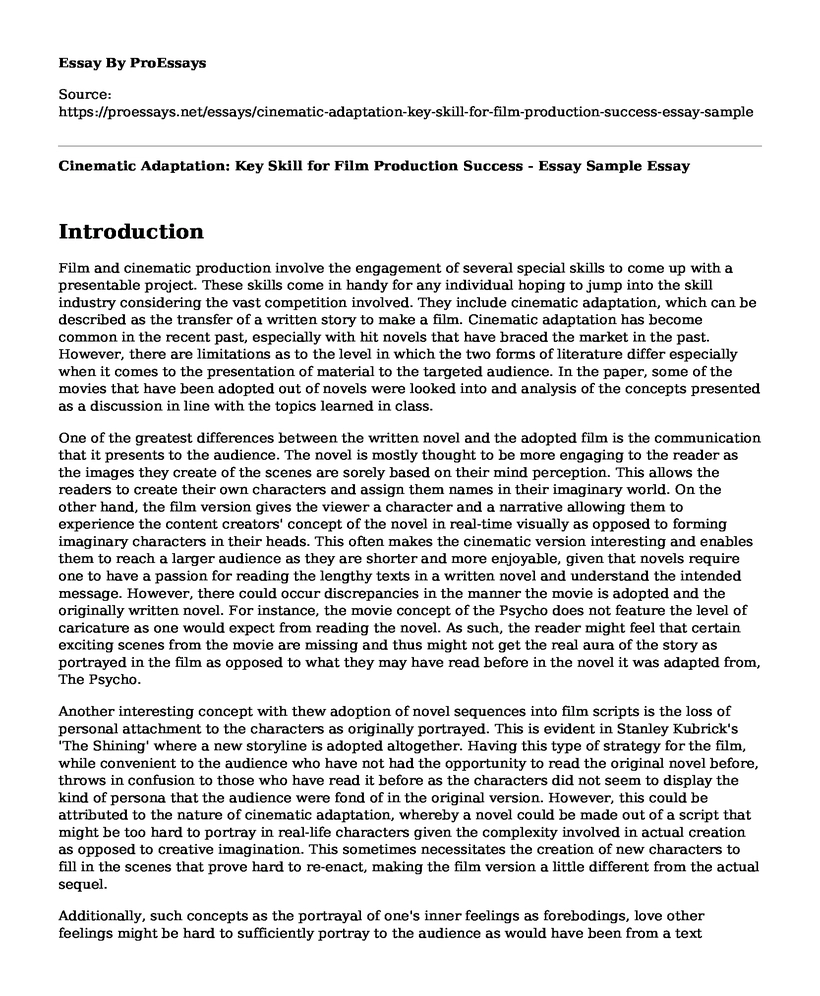Introduction
Film and cinematic production involve the engagement of several special skills to come up with a presentable project. These skills come in handy for any individual hoping to jump into the skill industry considering the vast competition involved. They include cinematic adaptation, which can be described as the transfer of a written story to make a film. Cinematic adaptation has become common in the recent past, especially with hit novels that have braced the market in the past. However, there are limitations as to the level in which the two forms of literature differ especially when it comes to the presentation of material to the targeted audience. In the paper, some of the movies that have been adopted out of novels were looked into and analysis of the concepts presented as a discussion in line with the topics learned in class.
One of the greatest differences between the written novel and the adopted film is the communication that it presents to the audience. The novel is mostly thought to be more engaging to the reader as the images they create of the scenes are sorely based on their mind perception. This allows the readers to create their own characters and assign them names in their imaginary world. On the other hand, the film version gives the viewer a character and a narrative allowing them to experience the content creators' concept of the novel in real-time visually as opposed to forming imaginary characters in their heads. This often makes the cinematic version interesting and enables them to reach a larger audience as they are shorter and more enjoyable, given that novels require one to have a passion for reading the lengthy texts in a written novel and understand the intended message. However, there could occur discrepancies in the manner the movie is adopted and the originally written novel. For instance, the movie concept of the Psycho does not feature the level of caricature as one would expect from reading the novel. As such, the reader might feel that certain exciting scenes from the movie are missing and thus might not get the real aura of the story as portrayed in the film as opposed to what they may have read before in the novel it was adapted from, The Psycho.
Another interesting concept with thew adoption of novel sequences into film scripts is the loss of personal attachment to the characters as originally portrayed. This is evident in Stanley Kubrick's 'The Shining' where a new storyline is adopted altogether. Having this type of strategy for the film, while convenient to the audience who have not had the opportunity to read the original novel before, throws in confusion to those who have read it before as the characters did not seem to display the kind of persona that the audience were fond of in the original version. However, this could be attributed to the nature of cinematic adaptation, whereby a novel could be made out of a script that might be too hard to portray in real-life characters given the complexity involved in actual creation as opposed to creative imagination. This sometimes necessitates the creation of new characters to fill in the scenes that prove hard to re-enact, making the film version a little different from the actual sequel.
Additionally, such concepts as the portrayal of one's inner feelings as forebodings, love other feelings might be hard to sufficiently portray to the audience as would have been from a text description, forcing the producers to adopt newer strategies to accommodate them. This would lead to extra costs t the production team, forcing them to turn to other means of expression that would lengthen or further shorten the narrative in an attempt to match with its original form.
'Facing Death' is another example of a successful cinematic adaptation. The film is about the health care system in the United States, especially where critically or terminally ill patients are involved. It speaks about the suffering of the patients and family of the individual and the processes that are followed in preparing the loved ones for the imminent loss of a family member. The film focuses mainly on the preparation of families of their patients in making decisions of life and death of their loved ones when the condition of the patient necessitates life support. It also revolves around the major decisions that have to be taken when handling the patients, especially where the options are limited. Moreover, it highlights the various methods that doctors use to handle complicated cases involving patients with little hopes of recovering from their life-threatening complications.
Conclusion
Through the video, we come to understand how our doctors work, their dedication and professionalism in efforts to preserve the lives of their patients no matter how bad their conditions are. Even more than this though, the video is a good reminder to the healthy people of just how precious a commodity life and health is, and that it should not at any moment be taken for granted, but that we should always strive to make the best of it while we still have an opportunity.
Cite this page
Cinematic Adaptation: Key Skill for Film Production Success - Essay Sample. (2023, Feb 17). Retrieved from https://proessays.net/essays/cinematic-adaptation-key-skill-for-film-production-success-essay-sample
If you are the original author of this essay and no longer wish to have it published on the ProEssays website, please click below to request its removal:
- Personality Theory in the Media
- Comparison of The Odyssey and O Brother, Where Art Thou? Essay
- Crossing the Farther Shore Essay Example
- Essay Sample on Blog Writing
- Movie Analysis Essay on The Inside Job
- Film Analysis Essay on West Side Story: A Cinematic Masterpiece That Will Leave You Spellbound
- Essay Example on Pitch Quality: Finding the Right Pitch for Your Audience







